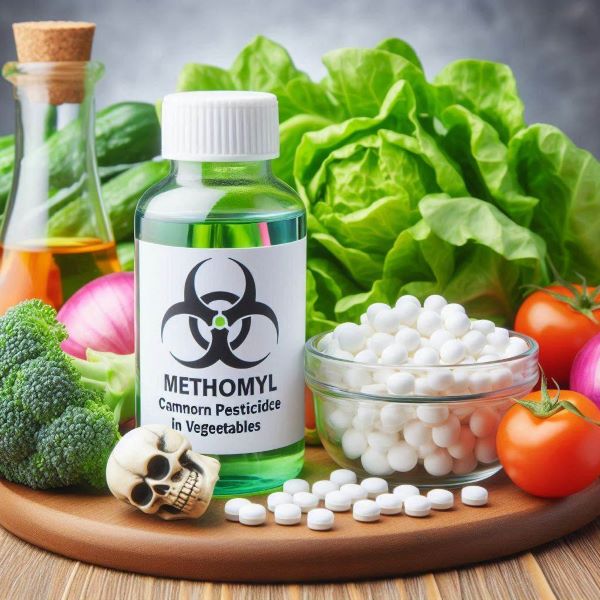Methomyl is a widely used carbamate pesticide employed in agricultural settings for its effectiveness against a broad spectrum of insect pests. Despite its efficacy, Methomyl has raised concerns due to its potential risks to human health and the environment. This article provides a comprehensive overview of Methomyl, including its description, usage, risks, and regulatory status in India and globally.
What is Methomyl?
It is a carbamate insecticide that works by inhibiting cholinesterase, an essential enzyme for proper nervous system function in insects. This inhibition leads to the accumulation of acetylcholine, causing continuous nerve signal transmission, which ultimately results in the insect’s death. Methomyl is known for its fast-acting properties and effectiveness against a wide range of pests. (Source)
Also, read: All You Need to Know about Endosulfan, A Common Pesticide Used in Vegetables
Description and Usage
Description: It is available in several formulations, including soluble concentrates, wettable powders, and granules. It is highly soluble in water and has a relatively short residual period in the environment compared to other pesticides. (Source)
Usage: It is used extensively in agriculture to protect various crops from insect infestations:
- Vegetables: Commonly applied to crops like tomatoes, potatoes, leafy greens, and beans to control pests such as aphids, caterpillars, and beetles.
- Fruits: Used on fruit crops like apples, grapes, and citrus fruits to manage pests like moths and fruit flies.
- Field Crops: Employed in the cultivation of crops such as maize, cotton, and rice to protect against a variety of insect pests.
Risks to Human Health and Environment
Health Risks: It poses several significant health risks:
- Acute Toxicity: Exposure to high levels of Methomyl can cause symptoms such as nausea, vomiting, abdominal cramps, excessive salivation, sweating, dizziness, and in severe cases, respiratory distress and death.
- Chronic Exposure: Prolonged exposure can lead to chronic health issues such as neurological disorders, cognitive impairment, and respiratory problems.
- Endocrine Disruption: There is evidence suggesting that Methomyl may interfere with hormonal systems, potentially leading to reproductive and developmental issues. (Source)
Environmental Risks: It also poses substantial risks to the environment:
- Water Contamination: Due to its high solubility, Methomyl can easily contaminate water bodies through runoff from agricultural fields, posing a threat to aquatic life.
- Soil Health: Although it degrades relatively quickly, Methomyl can still affect soil microorganisms, potentially disrupting soil health and fertility.
- Non-Target Species: It can be toxic to beneficial insects such as bees and predators of pests, as well as birds and aquatic organisms, leading to ecological imbalances. (Source)
Methomyl Use in India
States and Crops: It is used across various states in India, with significant application in states like Punjab, Haryana, Maharashtra, and Uttar Pradesh. It is particularly prevalent in the cultivation of vegetables such as tomatoes and potatoes, as well as in cotton and rice fields.
Regulatory Status in India: In India, it is regulated by the Central Insecticides Board and Registration Committee (CIBRC). While it is not banned, its use is subject to strict guidelines to mitigate risks to human health and the environment. Farmers are advised to follow proper application methods and safety protocols to minimize exposure and contamination. (Source)
Also, watch web stories: Ways to Reduce Toxins in Your Home Environment
Global Status of Methomyl
United States: The Environmental Protection Agency (EPA) regulates Methomyl under the Federal Insecticide, Fungicide, and Rodenticide Act (FIFRA). It is approved for use with specific restrictions to protect human health and the environment.
European Union: It is classified as a highly hazardous pesticide (HHP) by the European Food Safety Authority (EFSA). Its use is restricted, and it is subject to stringent regulations to ensure safety.
Other Countries:
- Australia: It is registered for use but is heavily regulated to ensure safe application.
- Canada: The Pest Management Regulatory Agency (PMRA) oversees Methomyl use, with stringent guidelines to protect human health and the environment.
- Brazil: Methomyl is used under strict regulatory oversight to manage its risks effectively.
FAQs
1. Is Methomyl safe for household use?
- No, due to its high toxicity, Methomyl is not recommended for household use and should only be applied by trained professionals in agricultural settings.
2. How can Methomyl exposure occur?
- Exposure can occur through inhalation, ingestion of contaminated food or water, and skin contact with treated plants or soil.
3. What are the symptoms of Methomyl poisoning?
- Symptoms include nausea, vomiting, abdominal pain, excessive salivation, sweating, dizziness, and respiratory distress in severe cases.
4. Are there safer alternatives to Methomyl?
- Yes, integrated pest management (IPM) strategies and the use of less toxic pesticides can provide effective pest control while reducing health and environmental risks.
5. Why is Methomyl controversial?
- Methomyl is controversial due to its high toxicity, potential health risks, and environmental impact, leading to stringent regulatory measures in many countries.





